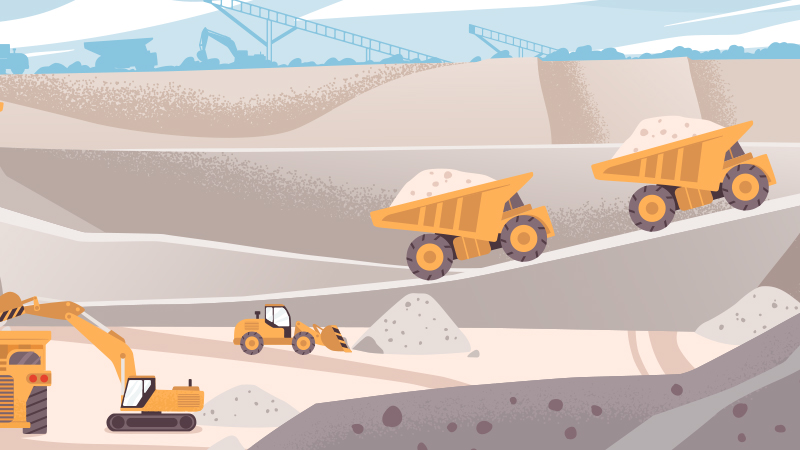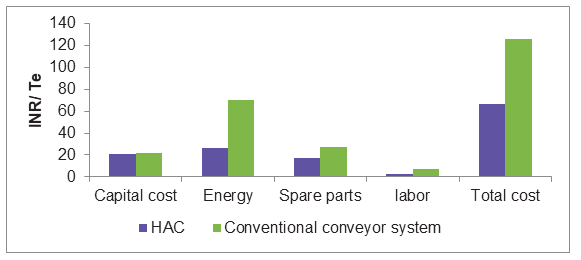
Sustainable Ore Transportation


A series of significant challenges, including an uncertain mining cycle and the intensification of environmental issues, has forced the mining industry into its next big transformation. Moreover, falling grades are forcing companies to target resources that were previously considered non economical. Mining firms are re-thinking their strategies in order to sustain themselves in this challenging business environment. This article discusses a comparative analysis of various ore transportation models and opportunities in sustainable mining solutions—specifically, In-Pit Crushing and Conveying (IPCC) and electric vehicles (EVs) (which aim at a drastic reduction in expense (capital expenditures (CAPEX) / operating expenses (OPEX)) along with a reduction in the carbon footprint), by highlighting various case studies implemented across the globe.
Introduction
The slump in the mining industry, especially in the current decade, has created an array of challenges for miners. Delays in demand recovery in the global economy and intensification of environmental commitments has forced mining companies to rethink their strategies to address these concerns. Transporting run off mine and verburden/gangue is an area of focus as it accounts for more than half of the operating cost. Depleting grades have further aggregated the operation scenario, which in turn, translate to added hauling distance. As the existing method would incur additional expenses, an alternate solution is required.
IPCC and electrical vehicles (EV) are the future. Recently, these proven and tested technologies have been used by major mining firms in pilot projects, and have resulted in significant direct and indirect cost savings. Though the initial capital involved is currently restricting the growth of these technologies, a long term benefits assessment indicates low operating expenses and a reduced carbon footprint, which would offset the initial investment.
Technology Overview
IPCC
IPCC is a single solution that combines various post-mining-pre-milling processes like crushing and transportation, and thus increases overall efficiency. It consists of conveyor system/high angle conveyor (HAC), a mobile crushing unit, and an electric shovel/hydraulic excavator. In more than 85% of studies, IPCC resulted in larger operating savings as compared to the truck/shovel model. In addition, the technology reduces one’s carbon footprint, and results in lower cost per ton and diesel consumption. The following flowchart provides a detailed explanation of the processes of the IPCC model.
Electric underground vehicles
California-based manufacturer Artisan Vehicles has developed fully-electric underground (UG) vehicles. The company, which initially established its public presence in the 2016 mine expo through the launch of its Load Haul Dump (LHD) (A4) UG mining, has developed world’s first fully-electric 40-ton haul truck.
An overview of the vehicles is presented in the following table.
|
Model Number |
Product Type |
Capacity (In tons) |
Capability/Key Insights |
|
A4 |
LHD |
4 |
|
|
Z40 |
Haul Truck |
4 |
|
|
A10 |
LHD |
10 |
|
Case Studies
Chuquicamata Copper Mine
-
This is one of the largest open pit mines in the world, with plans for transformation into a UG mine owing to the degrading quality of ore and impractical operating conditions. Haulers had to drive down 11-km to bring up lower grade ore to the surface. Thus, Codelco planned to invest almost $4 billion to replace the existing truck shovel system with the hauler system.
-
Mine development included 143 km of tunnels and 19 km of conveyor belts, with a capacity to haul 150,000 mt/day of crushed rock 900 m up to the surface.
-
Metso’s contract was booked by Codelco in Q2 2016, and the project is expected to continue till 2020.The scope of the contract includes engineering, supply of equipment and materials, and site assistance for 12 UG crusher stations combined with a conveyor package.
-
Transformation of the century-old mine from an open pit to UG operations by the block caving method is expected to extend the mine’s life by 40 years.
Central Iron Ore project
The largest magnetite project in Australia located in Eyre Peninsula is planned for mine optimization in 2014/2015 to extend mine life and increase output to 24 mtpa from 20 mtpa.
-
Feasibility study was conducted in 2014/15, and comparisons were made between the traditional approach, Hybrid IPCC, and fully-mobile IPCC
-
The results indicated that 350t trucks in the mine reduced from 93 in the conventional truck/shovel systems to 32 in semi mobile IPCC systems and to 12 in fully-mobile IPCC systems.
-
The OPEX cost reduced from $37.30/dmt (conventional truck/haul system) to $28.50/dmt (semi-mobile IPCC system)
-
The following table shows the complete comparison analysis between the traditional, hybrid IPCC, and fully-mobile IPCC.
|
|
Conventional Haul/Truck System, Operator-Owned Mining |
IPCC with Semi-Mobile Crushers Contract Mining, Semi-Mobile Crushers |
Fully-Mobile IPCC, Contract Mining, Hybrid Double Rolls Mobile Crushers |
|
797F Trucks (350t capacity) |
93 |
3212 |
12 |
|
Fuel Consumption (daily) |
800 kL |
150 kL |
50 kL |
|
Employees |
1150 |
350 |
250 |
|
Annual Capacity |
20 Mtpa |
21.5 Mtpa |
24 Mtpa |
|
OPEX (USD/dmt) |
37.50 |
28.50 |
N/A |
|
CO2 Diesel fuel burn-t/y (in thousands) |
797 |
149 |
N/A |
|
CO2 Electricity – t/y (in thousands) |
20 |
265 |
N/A |
|
CO2 Annual – t/y (in thousands) |
817 |
415 |
N/A |
Coal Mine project in India
- This case study involves a comparison between conventional conveyor systems and HAC systems for an open cast coal mine in India which has an annual production capacity of 3.5 mtpa.
- A mine optimization program resulted in halving the manpower, thus reducing the overall labor cost.
- The number of flight conveyors reduced from 4 to 1, and the route length reduced to 1/10th the original length.
- Another major factor is the reduction in the energy costs as the power consumed in the HAC system is 1800 KW compared to the 2400 KW in the conventional conveyor system.
All the aforementioned factors prove that the HAC system is most economical for ore transportation.
|
Parameters |
HAC |
Conventional Conveyor System |
|
Annual operating hours |
5000 |
5000 |
|
Route Length(m) |
450 |
4800 |
|
No. of units |
2 |
2 |
|
No. of flights |
1 |
4 |
|
KW |
1800 |
2400 |
|
Man power per shift |
4 |
8 |
|
Life of belting |
12 |
8 |
|
Investment(INR Million) |
500 |
400 |
Conclusion
In comparing various models, the IPCC resulted in additional savings in 85% of the cases.
A comparison of various ore transportation models are listed below.
- Despite higher investment costs, flexibility of the system coupled with a lower OPEX and carbon footprint make it the most suitable option in sustainable mining solutions.
- EVs have better cost benefits savings considering their operational efficiency and carbon footprint.
|
Ore Transportation Models |
Investment Cost |
Flexibility of the System |
Market Maturity of the Technology |
|
IPCC |
|
|
|
|
Haulers |
|
|
|
|
Train |
|
|
|
|
UG Electric |
 |
 |
 |
Related Insights:
View All
Get more stories like this
Subscirbe for more news,updates and insights from Beroe















C